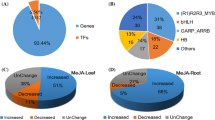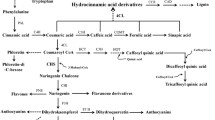Abstract
Cyclic GMP (cGMP) is an important signaling molecule that controls a range of cellular functions. So far, however, only a few genes have been found to be regulated by cGMP in higher plants. We investigated the cGMP-responsiveness of several genes encoding flavonoid-biosynthetic enzymes in soybean (Glycine max L.) involved in legume-specific isoflavone, phytoalexin and anthocyanin biosynthesis, such as phenylalanine ammonia-lyase, cinnamate 4-hydroxylase, 4-coumarate:CoA ligase, chalcone synthase, chalcone reductase, chalcone isomerase, 2-hydroxyisoflavanone synthase, 2-hydroxyisoflavanone dehydratase, anthocyanidin synthase, UDP-glucose:isoflavone 7-O-glucosyltransferase, and isoflavone reductase, and found that the majority of these genes were induced by cGMP but not by cAMP. All cGMP-induced genes were also stimulated by sodium nitroprusside (SNP), a nitric oxide (NO) donor, and illumination of cultured cells with white light. The NO-dependent induction of these genes was blocked by 6-anilino-5,8-quinolinedione, an inhibitor of guanylyl cyclase. Moreover, cGMP levels in cultured cells were transiently increased by SNP. Consistent with the increases of these transcripts, the accumulation of anthocyanin in response to cGMP, NO, and white light was observed. The treatment of soybean cotyledons with SNP resulted in a high accumulation of isoflavones such as daidzein and genistein. Loss- and gain-of-function experiments with the promoter of chalcone reductase gene indicated the Unit I-independent activation of gene expression by cGMP. Together, these results suggest that cGMP acts as a second messenger to activate the expression of genes for enzymes involved in the flavonoid biosynthetic pathway in soybean.






Similar content being viewed by others

Abbreviations
- NO:
-
Nitric oxide
- GC:
-
Guanylyl cyclase
- SNP:
-
Sodium nitroprusside
- CHS:
-
Chalcone synthase
- PAL:
-
Phenylalanine ammonia-lyase
- PR:
-
Pathogenesis-related
- LY83583:
-
6-Anilino-5, 8-quinolinedione
- 4CL:
-
4-Coumarate:CoA ligase
- IFGT:
-
UDP-glucose:isoflavone 7-O-glucosyltransferase
- CHR:
-
Chalcone reductase
- IFR:
-
Isoflavone reductase
- HIDH:
-
2-Hydroxyisoflavanone dehydratase
- C4H:
-
Cinnamate 4-hydroxylase
- CHI:
-
Chalcone isomerase
- IFS:
-
2-Hydroxyisoflavanone synthase
- ANS:
-
Anthocyanidin synthase
- GUS:
-
β-Glucuronidase
- LUC:
-
Luciferase
- DEANO:
-
Diethylamine NONOate
References
Akashi T, Aoki T, Ayabe S (2005) Molecular and biochemical characterization of 2-hydroxyisoflavanone dehydratase. Involvement of carboxylesterase-like proteins in leguminous isoflavone biosynthesis. Plant Physiol 137:882–891
Bariola PA, MacIntosh GC, Green PJ (1999) Regulation of S-like ribonuclease levels in Arabidopsis. Antisense inhibition of RNS1 or RNS2 elevates anthocyanin accumulation. Plant Physiol 119:331–342
Beligni MV, Lamattina L (2000) Nitric oxide stimulates seed germination and de-etiolation, and inhibits hypocotyl elongation, three light-inducible responses in plants. Planta 210:215–221
Bowler C, Neuhaus G, Yamagata H, Chua NH (1994a) Cyclic GMP and calcium mediate phytochrome phototransduction. Cell 77:73–81
Bowler C, Yamagata H, Neuhaus G, Chua NH (1994b) Phytochrome signal transduction pathways are regulated by reciprocal control mechanisms. Genes Dev 8:2188–2202
Cousson A (2003) Pharmacological evidence for a positive influence of the cyclic GMP-independent transduction on the cyclic GMP-mediated Ca2+-dependent pathway within the Arabidopsis stomatal opening in response to auxin. Plant Sci 164:759–767
Donaldson L, Ludidi N, Knight MR, Gehring C, Denby K (2004) Salt and osmotic stress cause rapid increases in Arabidopsis thaliana cGMP levels. FEBS Lett 569:317–320
Durner J, Wendehenne D, Klessig DF (1998) Defense gene induction in tobacco by nitric oxide, cyclic GMP and cyclic ADP-ribose. Proc Natl Acad Sci USA 95:10328–10333
Grün S, Lindermayr C, Sell S, Durner J (2006) Nitric oxide and gene regulation in plants. J Exp Bot 57:507–516
Hanafy KA, Krumenacker JS, Murad F (2001) NO, nitrotyrosine, and cyclic GMP in signal transduction. Med Sci Monit 7:801–819
Horn ME, Sherrard JH, Widhorm JM (1983) Photoautotrophic growth of soybean cells in suspension culture. Plant Physiol 72:426–429
Hu X, Neill SJ, Tnag Z, Cai W (2005) Nitric oxide mediates gravitropic bending in soybean roots. Plant Physiol 137:663–670
Kerckhoffs LHJ, Kendrick RE (1997) Photocontrol of anthocyanin biosynthesis in tomato. J Plant Res 110:141–149
Kuhn DN, Chappell J, Boudet A, Hahlbrock K (1984) Induction of phenylalanine ammonia-lyase and 4-coumarate:CoA ligase mRNAs in cultured plant cells by UV light or fungal elicitor. Proc Natl Acad Sci USA 81:1102–1106
Kwezi L, Meier S, Mungur L, Ruzvidzo O, Irving H, Gehring C (2007) The Arabidopsis thaliana brassinosteroid receptor (AtBRI1) contains a domain that functions as a guanylyl cyclase in vitro. PLoS ONE 2:e449
Lamattina L, Garcia-Mata C, Graziano M, Pagnussat G (2003) Nitric oxide: the versatility of an extensive signal molecule. Annu Rev Plant Biol 54:109–136
Lindermayr C, Durner J (2007) S-Nitrosylation in plants- spectrum and selectivity. In: Lamattina L, Polacco JC (eds) Nitric oxide in plant growth, development and stress physiology. Springer, Berlin, pp 53–71
Ludidi N, Gehring C (2003) Identification of a novel protein with guanylyl cyclase activity in Arabidopsis thaliana. J Biol Chem 278:6490–6494
Maathuis FJ (2006) cGMP modulates gene transcription and cation transport in Arabidopsis roots. Plant J 5:700–711
Martin C, Prescott A, Mackay S, Bartlett J, Vrijlandt E (1991) Control of anthocyanin biosynthesis in flowers of Antirrhinum majus. Plant J 1:37–49
Modolo LV, Cunha FQ, Braga MR, Salgado I (2002) Nitric oxide synthase-mediated phytoalexin accumulation in soybean cotyledons in response to the Diaporthe phaseolorum f. sp. meridionalis elicitor. Plant Physiol 130:1288–1297
Neill SJ, Desikan R, Hancock JT (2003) Nitric oxide signalling in plants. New Phytol 159:11–35
Neuhaus G, Bowler C, Hiratsuka K, Yamagata H, Chua NH (1997) Phytochrome-regulated repression of gene expression requires calcium and cGMP. EMBO J 16:2554–2564
Newton RP, Chiatante D, Ghosh D, Brenton AG, Walton TJ, Harris FM, Brown EG (1989) Identification of cyclic nucleotide constituents of meristematic and non-meristematic tissues of Pisum sativum roots. Phytochemistry 28:2243–2254
Newton RP, Smith CJ (2004) Cyclic nucleotides. Phytochemistry 65:2423–2437
Noguchi A, Saito A, Homma Y, Nakao M, Sasaki N, Nishino T, Takahashi S, Nakayama T (2007) UDP-glucose:isoflavone 7-O-glucosyltransferase from the roots of soybean (Glycine max) seedlings: purification, gene cloning, phylogenetics, and an implication for an alternative strategy of enzyme catalysis. J Biol Chem 282:23581–23590
Pagnussat GC, Lanteri ML, Lamattina L (2003) Nitric oxide and cyclic GMP are messengers in the indole acetic acid-induced adventitious rooting process. Plant Physiol 132:1241–1248
Penson SP, Schuurink RC, Fath A, Gubler F, Jacobsen JV, Jones RL (1996) cGMP is required for gibberellic acid-induced gene expression in barley aleurone. Plant Cell 8:2325–2333
Pilz RB, Casteel DE (2003) Regulation of gene expression by cyclic GMP. Circ Res 93:1034–1046
Prado AM, Porterfield DM, Feijó JA (2004) Nitric oxide is involved in growth regulation and re-orientation of pollen tubes. Development 131:2707–2714
Russwurm M, Koesling D (2004) NO activation of guanylyl cyclase. EMBO J 23:4443–4450
Sambrook J, Russell DW (eds) (2001) Molecular cloning: a laboratory manual, 3rd edn. Cold Spring Harbor, NY
Schijlen EGWM, Ric de Vos CH, van Tunen AJ, Bovy AG (2004) Modification of flavonoid biosynthesis in crop plants. Phytochemistry 65:2631–2648
Subramanian S, Stacey G, Yu O (2007) Distinct, crucial roles of flavonoids during legume nodulation. Trends Plant Sci 12:282–285
Szmidt-Jaworska A, Jaworski K, Tretyn A, Kopcewicz J (2004) The involvement of cyclic GMP in the photoperiodic flower induction of Pharbitis nil. J Plant Physiol 161:277–284
Terzaghi WB, Cashmore AR (1995) Light-regulated transcription. Annu Rev Plant Physiol Plant Mol Biol 46:445–474
Uhlmann A, Ebel J (1993) Molecular cloning and expression of 4-coumarate:coenzyme A ligase, an enzyme involved in the resistance response of soybean (Glycine max L.) against pathogen attack. Plant Physiol 102:1147–1156
Ulker B, Somssich E (2004) WRKY transcription factors: from DNA binding towards biological function. Curr Opin Plant Biol 7:491–498
Welle R, Schröder G, Schiltz E, Grisebach H, Schröder J (1991) Induced plant responses to pathogen attack. Analysis and heterologous expresson of the key enzyme in the biosynthesis of phytoalexins in soybean (Glycine max L. Merr. Cv. Harosoy 63). Eur J Biochem 196:423–430
Wendehenne D, Courtois C, Besson A, Gravot A, Buchwalter A, Pugin A, Lamotte O (2007) NO-based signaling in plants. In: Lamattina L, Polacco JC (eds) Nitric oxide in plant growth, development and stress physiology. Springer, Berlin, pp 35–51
Wu Y, Hiratsuka K, Neuhaus G, Chua NH (1996) Calcium and cGMP target distinct phytochrome-responsive elements. Plant J 10:1149–1154
Yamagata H, Masuzawa T, Nagaoka Y, Ohnishi T, Iwasaki T (1994) Cucumisin, a serine protease from melon fruits, shares structural homology with subtilisin and is generated from a large precursor. J Biol Chem 269:32725–32731
Yamagata H, Saka K, Tanaka T, Aizono Y (2001) Light activates a 46-kDa MAP kinase-like protein kinasa in soybean cell culture. FEBS Lett 494:24–29
Yamagata H, Yonesu K, Hirata A, Aizono Y (2002) TGTCACA is a novel cis-regulatory enhancer element involved in fruit-specific expression of the cucumisin gene. J Biol Chem 277:11582–11590
Acknowledgments
We thank Dr. J.M. Widholm for the gift of soybean SB-P culture, Drs. M. Sasaki and K. Kanazawa for their help with HPLC, Prof. N.-H. Chua, in whose laboratory this work was started, and Dr. C. Bowler for critical reading of the manuscript. This research was supported by Grants-in Aid for Scientific Research (No. 16380071) from the Ministry of Education, Culture, Science, Sports, and Technology of Japan, and grants from Fuji Foundation for Protein Research to H.Y.
Author information
Authors and Affiliations
Corresponding author
Additional information
The nucleotide sequence for the promoter of the soybean chalcone reductase gene has been deposited in the GenBank database under GenBank accession number EU157917.
Rights and permissions
About this article
Cite this article
Suita, K., Kiryu, T., Sawada, M. et al. Cyclic GMP acts as a common regulator for the transcriptional activation of the flavonoid biosynthetic pathway in soybean. Planta 229, 403–413 (2009). https://doi.org/10.1007/s00425-008-0839-5
Received:
Accepted:
Published:
Issue Date:
DOI: https://doi.org/10.1007/s00425-008-0839-5



